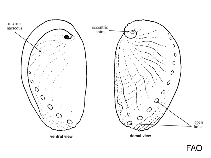Haliotis iris Martyn, 1784
Black pauaGoogle image | No image available for this species;
drawing shows typical species in Haliotidae.
Classification / Names ชื่อสามัญ | ชื่อพ้อง | CoL | ITIS | WoRMS
Gastropoda | Lepetellida | Haliotidae
Environment: milieu / climate zone / ระดับความลึก / distribution range นิเวศวิทยา
. Tropical
Distribution ประเทศต่างๆ | พื้นที่จำแนกตาม FAO | ระบบนิเวศหลายระบบ | การปรากฏขึ้น,การเกิดขึ้น,พบ | การแนะนำ
Southwest Pacific: New Zealand.
Length at first maturity / ขนาด / Weight / Age
วัยเจริญพันธุ์: Lm ?, range 5 - 8 cm
Life cycle and mating behavior วัยเจริญพันธุ์ | การสืบพันธุ์ | การวางไข่ | Eggs | ความดกของไข่ | Larvae
Main reference
อ้างอิง | ผู้ประสานงาน | ผู้ร่วมมือ
Poore, G.C.B. 1972 Ecology of New Zealand abalones, Haliotis species (Mollusca: Gastropoda). N.Z. Journal of Marine and Freshwater Research 6:11-22. (อ้างอิง 82725)
IUCN Red List Status
(อ้างอิง 130435: Version 2025-1)
CITES status (อ้างอิง 108899)
CMS (อ้างอิง 116361)
Threat to humans
Human uses
การประมง: การค้า
| FishSource |
เครื่องมือ
ข้อมูลเพิ่มเติม
Max. ages / sizes
Length-weight rel.
Length-length rel.
Length-frequencies
Mass conversion
อุดมสมบรูณ์
แหล่งที่มาจากอินเตอร์เน็ต
BHL | BOLD Systems | CISTI | DiscoverLife | FAO(Publication : search) | Fishipedia | GenBank (genome, nucleotide) | GloBI | Gomexsi | Google Books | Google Scholar | Google | PubMed | แผนภูมิชีวิตแบบต้นไม้ | Wikipedia (Go, ค้นหา) | บันทึกทางด้านสัตววิทยา



